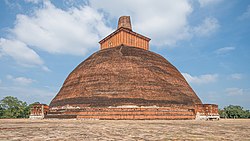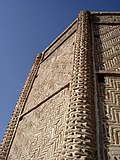Brick



A brick is a man-made building material used to make walls and make places to walk. It is a single unit of a kneaded clay-bearing soil, sand and lime, or concrete material, fire-hardened or air-dried, used in masonry construction.
Bricks are made mostly of clay. They are put into molds or cut with wires, and then baked in an oven. The color of a brick depends on the clay from which it was made.
Masons build brick walls. They join bricks together using mortar. Bricks can be assembled into many different patterns. The most common pattern is called "running bond". A row of bricks is called a course.
Bricks used outdoors on the ground are called "pavers". Engineering bricks are used for high load-bearing walls, and for damp-proof courses. They are more expensive, and are made of better clays and fired at a higher temperature.
History
The oldest shaped bricks found date back to 7500 B.C. They have been found in Çayönü, a place in the upper Tigris area in south east Anatolia, close to Diyarbakir. A bit later, between 7000 and 6395 BC, bricks come from Jericho and Catal Hüyük.
Fired bricks are one of the longest-lasting and strongest building materials. They have been used since about 3000 BC in early Indus Valley cities.[1] Sun-dried mud bricks are much older, and quite satisfactory in hot, dry climates. Fired bricks are much more resistant to cold and moist weather conditions. They allow permanent building in regions where the harsher climate prevents the use of mud bricks.
Most bricks from all places tend to be about the same size: ~9 x ~4¼ x ~2½ inches or 250 × 120 × 65 mm. This is because they are picked up by the brickie in one hand, while in his other hand is a trowel with cement on it.
Cement
Just as bricks are ancient (probably Neolithic in origin), so is cement. That is (in comparison) a more recent invention. The ancient Greeks and Romans used cement. Older civilizations knew, however, that bricks needed to be stuck together. The Babylonians and Assyrians used bitumen to bind together burnt brick or alabaster slabs. Bitumen comes out of the ground naturally in a few places. It is a black oily substance of organic origin, like oil or pitch.
In Ancient Egypt, stone blocks were cemented together with a mortar made of sand and roughly burnt gypsum (CaSO4 · 2H2O), which often contained calcium carbonate (CaCO3).[2]
Other images
Brick making in Madagascar
Woman of Tanzania carrying bricks on her head
Brick Media
Brickwork in Khosrow Abad Gerrus Mosque, Iran
The ancient Jetavanaramaya stupa of Anuradhapura in Sri Lanka is one of the largest brick structures in the world.
The brickwork of Shebeli Tower in Iran displays 12th-century craftsmanship
Brick relief sculpture by Walter Ritchie
The Roman Basilica Aula Palatina in Trier, Germany, built with fired bricks in the fourth century as an audience hall for Constantine I
Malbork Castle of the Teutonic Order in Poland – the largest brick castle in the world
In the National Museum of Roman Art in Mérida, Spain (designed by Rafael Moneo and built in the 1980s) the coating of hard-fired clay bricks forms a compression-resistant element together with the fill of non-reinforced concrete.
References
| Wikimedia Commons has media related to Lua error in Module:Commons_link at line 62: attempt to index field 'wikibase' (a nil value).. |












